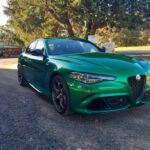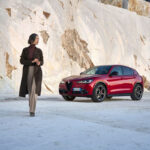
The number of sports sedans available to Aussie drivers continues to shrink.
Ford and Holden’s offerings are no more and the Chrysler 300 is over and out too.
That leaves the Germans, the Genesis G70 and maybe the Lexus IS350 F-Sport — and of
course Alfa Romeo Giulia.
Who could forget the Giulia, the car and platform with the very future of the storied brand
riding on its elegant back.
If there’s one thing the Italians know how to do and do well, it’s design and build great-
looking cars with impeccable road manners – and Giulia is one of them.
STYLING
Introduced in 2015 as a replacement for the 159, Giulia was last updated in 2021.
It’s not just a good-looking car, but a veritable work of art, with its deep V-shaped signature
grille.
But it looks like Alfa has quietly trimmed the lineup since our last encounter because just
two out of the five models remaining.
There’s the four-cylinder Giulia Veloce priced from $74,950 and from there it doubles up to
the twin-turbo V6 Quadrifoglio at twice the price and power — $152,360 before on-road
costs.
Our test vehicle was the Veloce with a few bits and pieces added.
Standard kit includes 19-inch alloys, the Q2 limited slip rear diff and a sports body kit with
dual exhausts.
It appears the Veloce no longer comes with Alfa active suspension, although we’re still
waiting for Alfa to confirm this development.

There’s also leather trim and dual-zone climate air, a heated steering wheel, heated eight-
way power adjust front seats with driver memory and power-adjust seat bolsters,
aluminium pedals and dash insert plus ambient interior lighting.
Add to this adaptive bi-xenon headlights, keyless entry and start, auto engine stop-start,
auto lights and wipers, auto dimming rear view mirror, front and rear parking sensors and a
reverse parking camera with dynamic guidelines — plus wireless phone charging.
Other options include metallic paint at $1355 (exxy), Tri-Colour paint $2755 (even exxier),
Dual-pane sunroof $2255 (don’t like sunroofs), Black or Yellow brake calipers ($755) and
20-inch Veloce Five-Hole Alloy Wheels ($700).
We’d say yes to the audio, painted calipers and alloys. The good news is that basic Alfa
red will cost you nothing.
Giulia now comes with a five-year warranty and five-year roadside assistance, with service
intervals pegged at 12 months/15,000km.
INFOTAINMENT
Infotainment comes in the form of an 8.8-inch touchscreen with eight-speaker audio, built-
in navigation, AM/FM/DAB radio, voice control, Bluetooth with audio streaming plus Apple
CarPlay and Android Auto connectivity.
There’s USB-A and -C ports and an AUX input in the front as well as another USB port in
the back — and praise be a physical volume knob.

Premium 14-speaker Harman Kardon audio is available as a $1255 option which sounds
like a pretty good deal.
ENGINES / TRANSMISSIONS
The 2.0-litre turbocharged four-cylinder engine in the Veloce develops 206kW of power at
5250 rpm and 400Nm of torque from 2250 rpm.
With a 58-litre tank and auto engine stop-start, it uses a claimed 6.1 litres of 95 RON
premium per 100km and generates 141g of CO2 per kilometre.
Drive is to the rear wheels through an 8-speed ZF automatic and limited slip rear diff, with
large metal paddle shifts fixed to the steering column rather than rotating with the wheel.
SAFETY
Crash tested back in 2016 Giulia scores a full five-star safety rating with six airbags, rear
view camera, Forward Collision Warning (FCW) and Autonomous Emergency Braking
(City, Interurban and Vulnerable Road User).
There’s also Lane Departure Warning (LDW), Active Blind Spot Assist and Driver Attention
Assist — but no auto braking in reverse.
Add to this Active Cruise Control, Traffic Sign Recognition with Intelligent Speed Control
and Automatic High Beam Assist.
Driver Attention Assist monitors the movements of the vehicle via the Multi-Touch Display
program and encourages drivers to rest when drowsy.
DRIVING
Alfa’s first rear drive sedan in years, Giulia was designed with a clear emphasis on
performance.
It had to channel the brand’s heritage, its ‘Italian-ness’ and design DNA, but also had to be
better than its German rivals if it was to beat them at their own game.
Befitting its role as a sports sedan, the compact dimensions suggest agility, with a cabin
that follows a traditional design route.
There are heavily bolstered leather sports seats and old-style, driver focused analogue
instrument dials.
A smallish-looking touchscreen can be found inset in the dash, where it is less intrusive —
but close enough if and when you need it.
Remember, it’s not the destination but the journey that counts here.
The start button is hidden in full sight on the steering wheel like a Ferrari, rather than
hidden somewhere in and around the dash.
If you’re of a certain age, then you need to be aware that Giulia sits reasonably low to the
ground and the heavily bolstered seats can make entry and exit a little difficult.
In the back, rear legroom is tight, especially with the front seats set back, while the boot
though deep is fairly shallow, with a smallish opening that will limit what you can get in
there anyway.
Neither of the four- or six-cylinder engines offered have anything to do with Ferrari,
although engine development was headed up by a former Ferrari guy.
Weighing in at a trim 1490kg, the dash from 0-100km/h takes 5.7 seconds and it has a top
speed of 240km/h — not lightning quick but quick enough to whet the appetite.
Helping to keep weight down is a carbon-fibre drive shaft as well as aluminium shock
towers, suspension components, front wings and doors.
At this point it’s worth mentioning the DNA control dial located close to hand on the centre
console.
It provides access to sport mode and, in the previous model, there was another less
conspicuous button in the centre of the dial that could be used to soften the adjustable
suspension in sport mode if necessary.
It’s no longer there.
DNA stands for Dynamic, Natural and Advanced efficiency — in other words Sport, Normal
and Eco.
Dynamic dials up the excitement, with sharper braking and steering, plus more aggressive
engine, transmission and throttle tip-in calibrations.
It also adds some snarl to the exhaust note, although it could and should be louder.
It wasn’t that long ago that cars that could hit the 100km/h mark in 6.0 seconds or less
were considered high performance.
Times have kept tumbling, but Veloce still feels plenty quick.
While there’s a slight hesitation in the default mode, the car really starts to spark in
Dynamic mode.
There’s plenty of torque down low which makes it easy to drive in the cut and thrust of city
traffic, but a car like this really demands the open road.
You can tell Giulia is a driver’s car from the way it responds, the way it turns easily into
corners and the way it communicates what is happening to the driver.
It has a real planted feel with electric variable power steering that is quick, light and direct.
Heading into our first corner, at a somewhat faster speed than your average punter, the
car turns in eagerly, almost as though it knows the way.
Squirming, the car feels like it’s almost alive under our feet, with the diff and suspension
working in tandem, with plenty of help from grippy Pirellis.
The brakes are brilliant, strong and progressive, enabling late braking into corners, with a
little lift-off oversteer evident.
With staggered run flat 225/40 series rubber at front and wider 255/35s at the rear, the ride
is outstanding — even without the aid of active suspension.
It’s only on choppy city roads, like Sydney’s Parramatta Rd, that it starts to become
uncomfortable.
Gear changes from the ZF transmission are smooth and timely, but moving between
forward and reverse can be awkward during parking manoeuvres.
The paddle shifts are nice to have for engine braking or to grab a quick gear, but Drive and
Dynamic mode are almost as good.
Importantly, Giulia is fun to drive and while there’s always the M3-beating 375kW
Quadrifoglio to consider — for our money four-cylinder engines are what Alfa does best.
We were getting 9.8L/100km after more than 350km — not quite the promised 6.1 but
liveable for a sports sedan.
The Veloce gets our vote. Bellissimo.
SUMMING UP
We motoring journos have a short list of cars we’d rather not give back. The Alfa Romeo
Giulia is one of them.
It’s a real driver’s car, with a punchy turbo engine and rear-wheel drive, along with a limited
slip diff to keep things nice and neat.
Throw in stunning good looks and it’s a hard one to pass up, particularly at the price point.
Waddaya reckon Alfa: Finder’s Keepers?
RATINGS:
Looks: 8.5/10
Performance: 7.5/10
Safety: 7.5/10
Thirst: 7.5/10
Practicality: 6/10.5
Comfort: 7/10
Tech: 7.5/10
Value: 8.5/10
Overall: 7.6/10
AT A GLANCE
MODEL RANGE
Alfa Romeo Giulia Veloce: $71,950
Alfa Romeo Giulia Quadrifoglio: $143,500
Options: Dual sunroof: $2255
Harman Kardon audio: $1255
Metallic paint: $1355
Note: These prices do not include government or dealer delivery charges. Contact your
local Alfa Romeo dealer for drive-away prices.
SPECIFICATIONS (Alfa Romeo Giulia Veloce 2.0-litre turbo petrol, eight-speed automatic,
RWD)
ENGINE:
Capacity: 2.0 litres
Configuration: Four cylinders inline
Maximum Power: 206 kW @ 5250 rpm
Maximum Torque: 400 Nm @ 2250 rpm
Fuel Type: 95 RON unleaded petrol
Combined Fuel Cycle (ADR 81/02): 6.1 L/100km
CO2 emissions 141 g / km
DRIVELINE: 8 speed ZF automatic, rear-wheel drive
DIMENSIONS, WEIGHT AND CAPACITIES:
Length: 4643 mm
Wheelbase: 2820 mm
Width: 1860 mm
Height: 1436 mm
Turning Circle: 10.9 metres
Tare Mass:1490 kg
Fuel Tank Capacity: 58 litres
BRAKES:
Front: Ventilated disc
Rear: Ventilated disc
STANDARD WARRANTY:
Five years / unlimited kilometres











